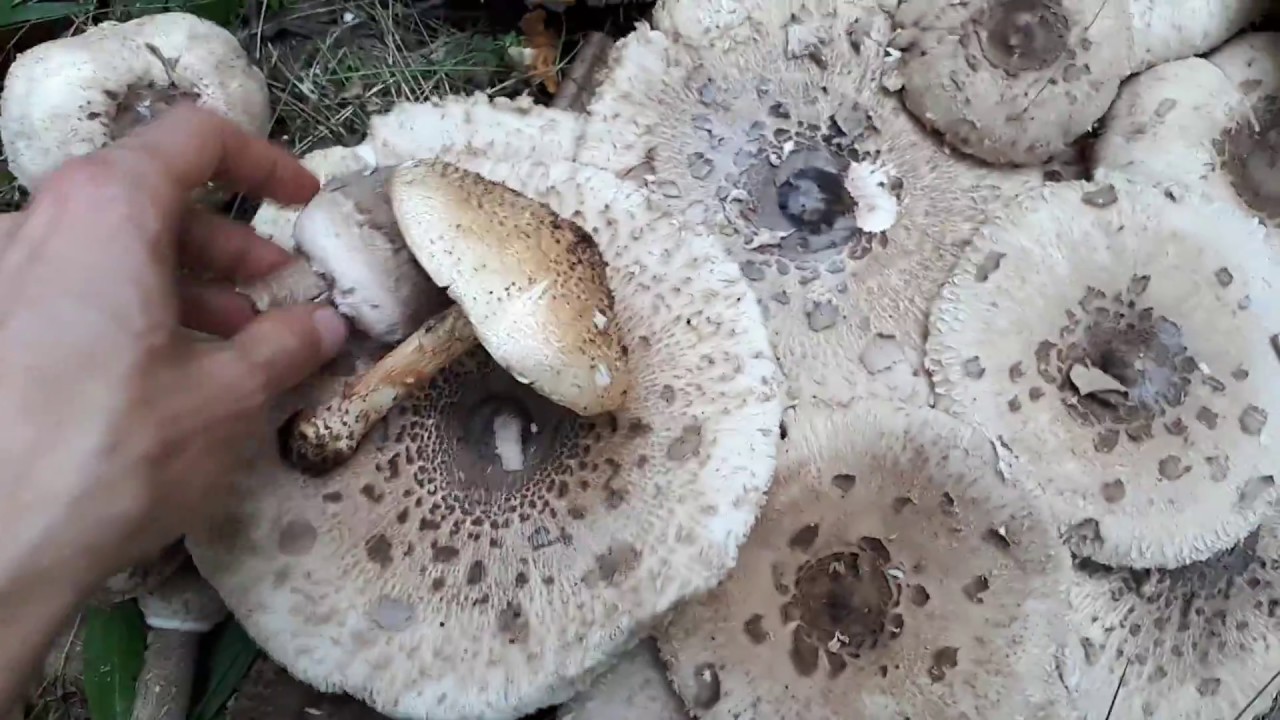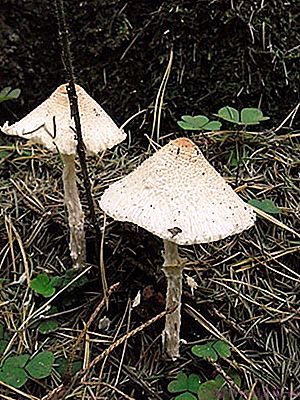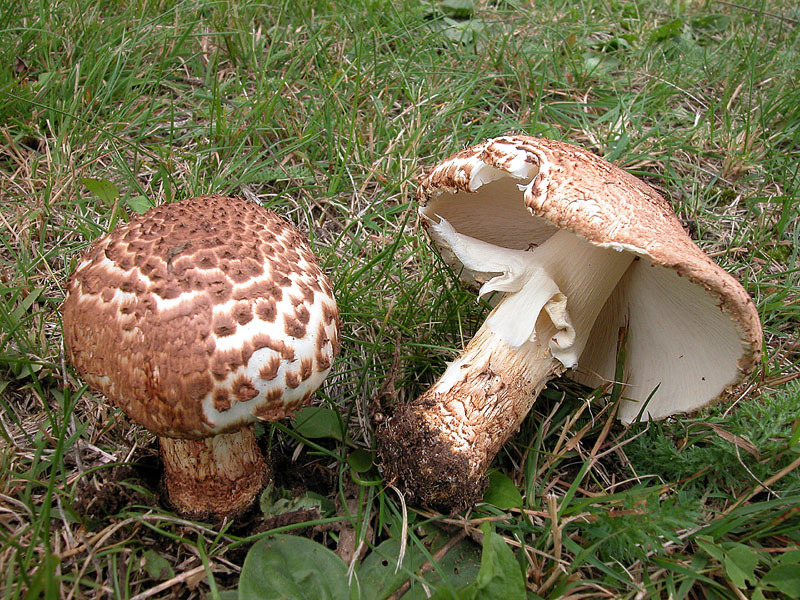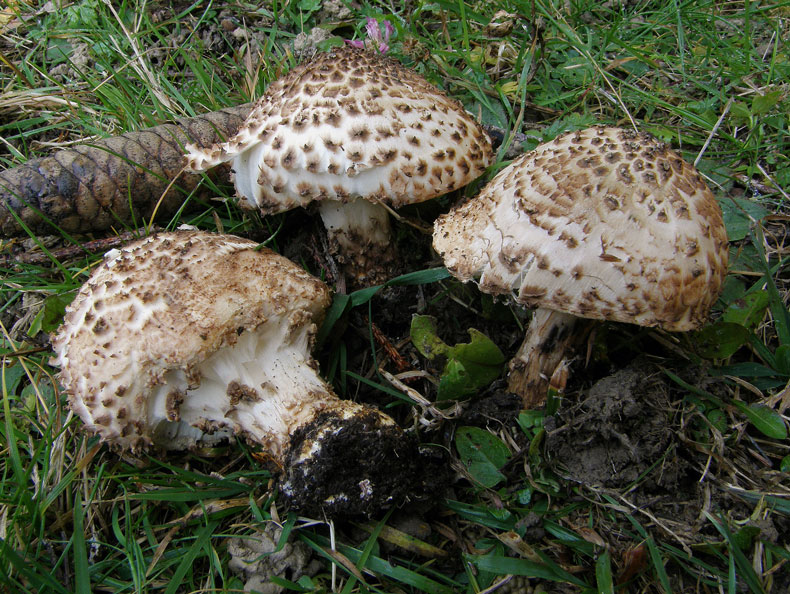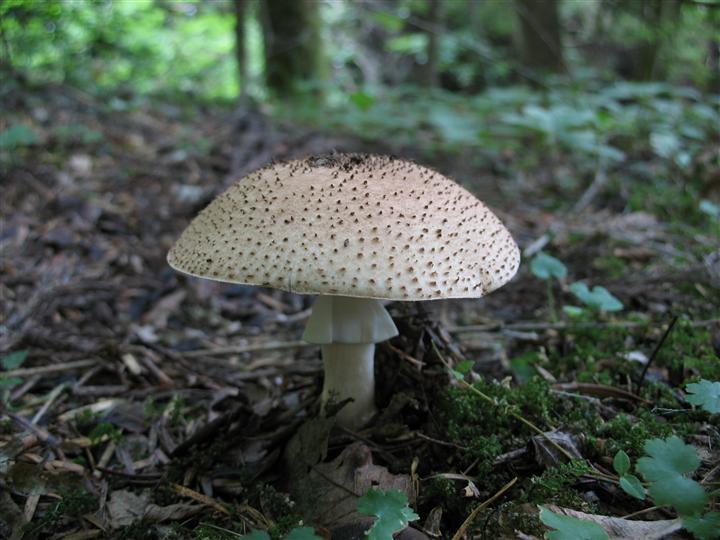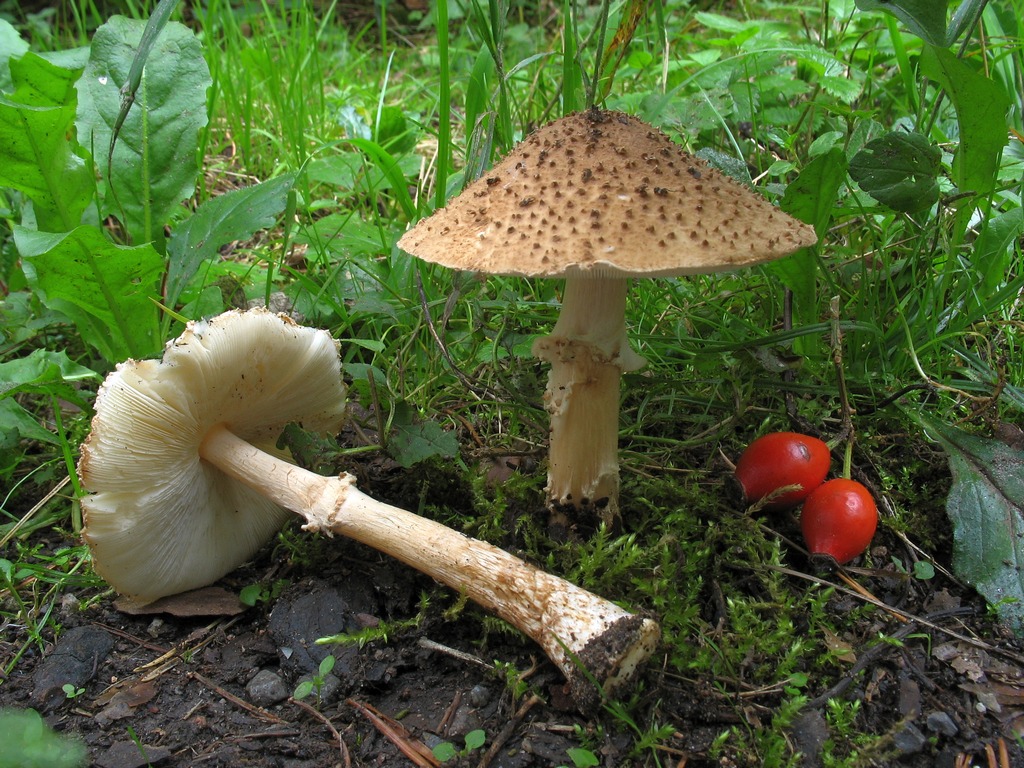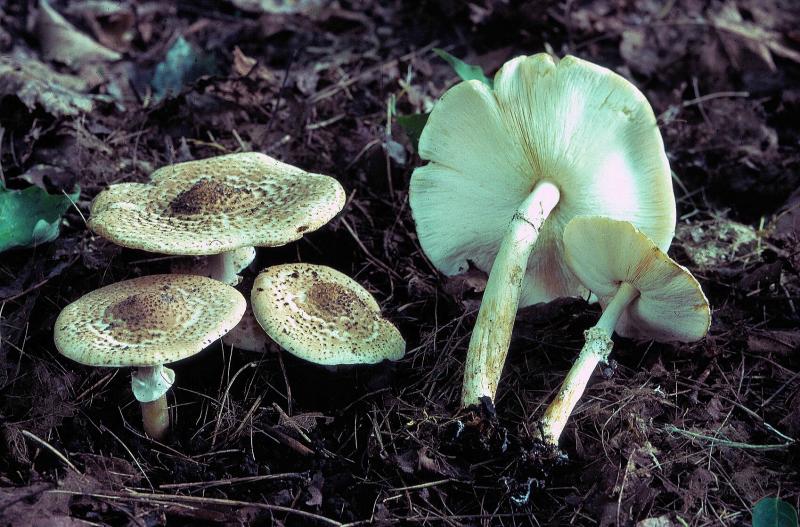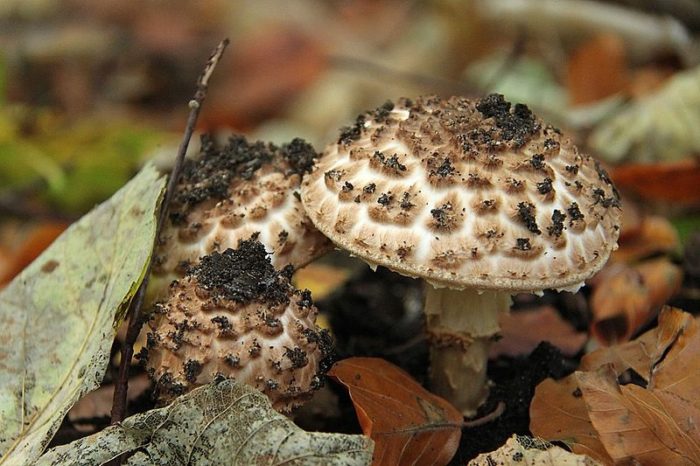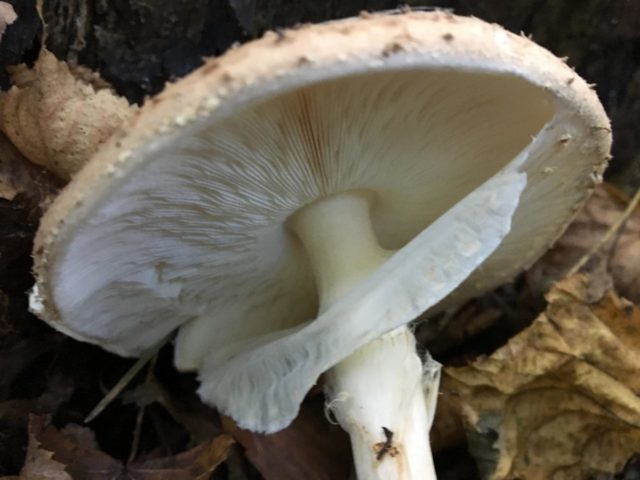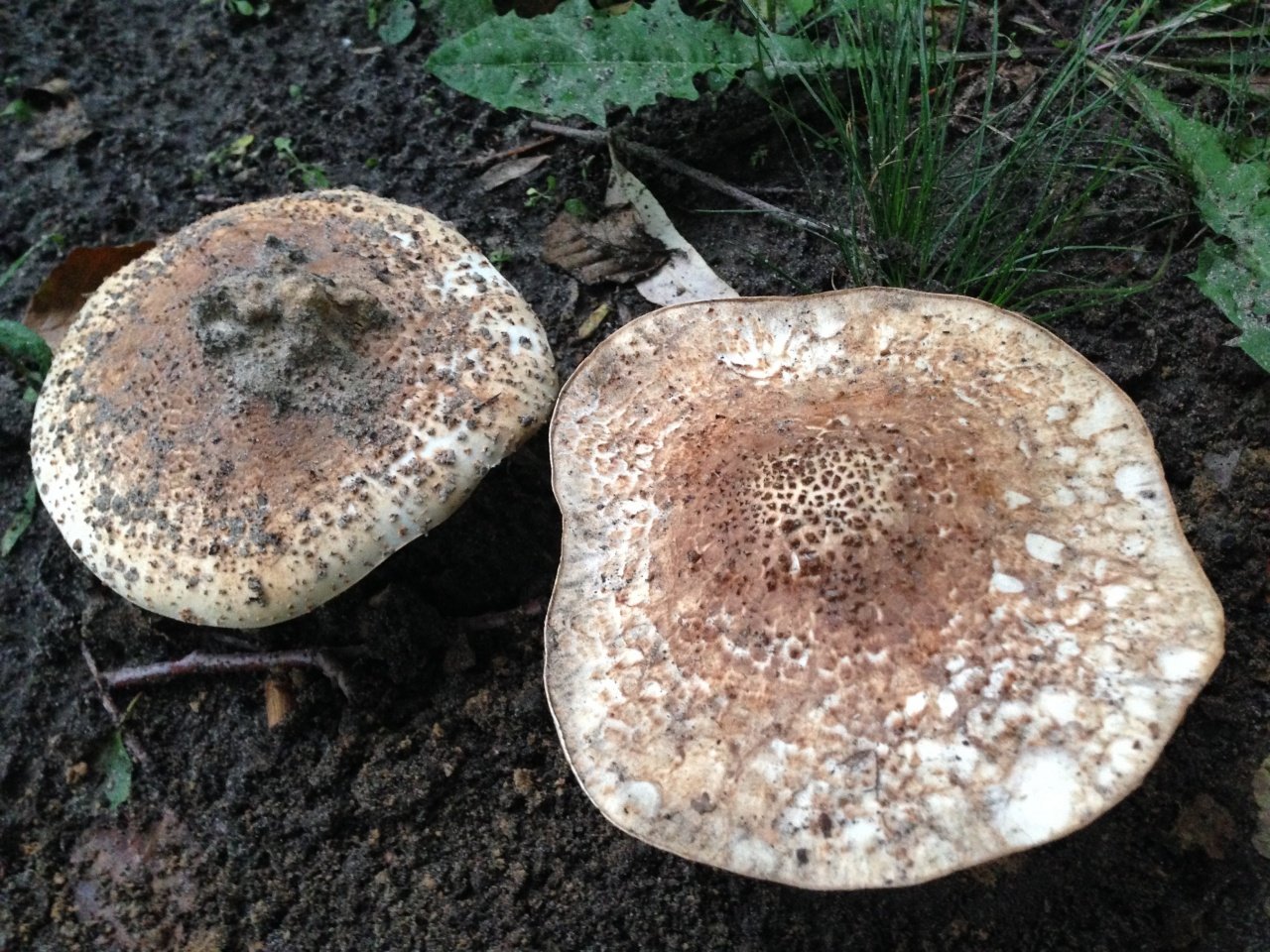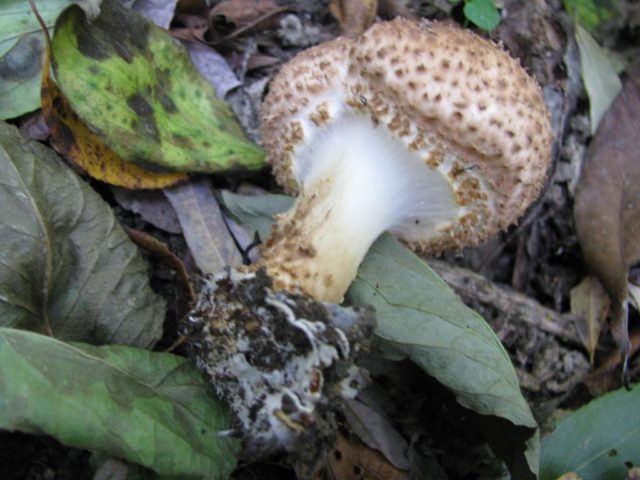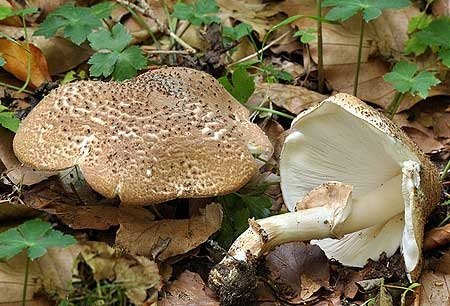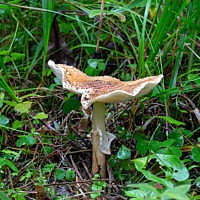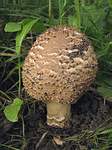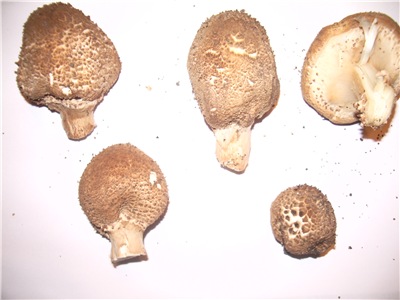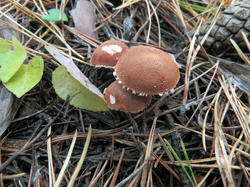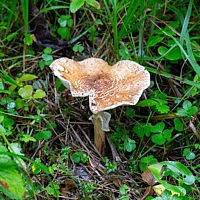Poisonous Umbrella Mushrooms
Among the numerous genus Macrolepiota, there are specimens that almost do not differ from the edible in appearance, but are considered poisonous. These include the umbrella comb, chestnut, fleshy red, brownish red and rough. The most dangerous are the first 2 types.
Chestnut

Chestnut lepiota has a red or brown head, the diameter of which does not exceed 4 cm. The head of the chestnut umbrella mushroom at a young age has an ovoid shape, then takes the form of a prostrate dome. A small tubercle remains in the center. Gradually, the skin of the cap cracks, small scales and brownish color are formed.
As the plates grow, they turn yellow. The reddish or brown flesh is highly fragile and has an unpleasant odor. The leg is in the form of a narrow cylinder, expanding closer to the base. The ring is white, but gradually becomes thinner and disappears completely.
The chestnut umbrella is very poisonous, in most cases the use of this product in food is fatal.
Comb

The hat of young umbrellas is bell-shaped, later becoming like a wide dome up to 10 cm in diameter. Its surface is red-brown or dark brown, covered with orange or yellow scales with sharp tips.
The leg in the upper part is cylindrical, hollow, thin, 7-10 cm high and no more than 5 mm in diameter. It differs in a variety of tones - from yellow to cream, but it can also have a brown tint. In young specimens, a wide membranous ring is clearly visible, white or pink, but quickly disappears as it grows.
The pulp of the mushroom is white, has an unpleasant odor and taste.
Crested lepiota is a poisonous species and is not eaten.
Rough
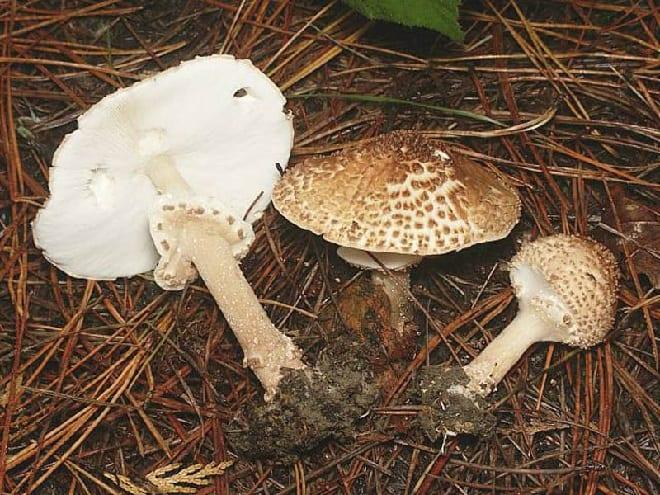
The cap of a scaly lepiota is capable of reaching 15 cm in diameter, bell-shaped. As they grow older, it becomes prostrate or convex, with a wide tubercle in the central part. The surface of the cap is very dry, reminiscent of felt. Color - from yellowish to light brown. The scales are darker, pyramidal, and large.
The blades of the umbrella mushroom are under a white blanket, which later transforms into a thin, white, cobweb ring with brown scales on the lower part. The color of the plates is from white to cream.
The stem, which has a tuberous shape at the base, is thin (10-15 mm) and long (up to 12 cm), hollow. Above the ring it is distinguished by a light shade, under it - yellow or brownish, fibrous, covered with scales, cylindrical in shape.
The pulp of Lepiota rough has an unpleasant, strong resinous odor and a bitter taste. Not used for food.
Notes (edit)
- ↑
- ↑
- Vyacheslav Stepanov. ... Mushrooms of the Kaluga region. Date of treatment June 21, 2011.
- Quélet, Lucien. Enchiridion Fungorum in Europa media et praesertim in Gallia Vigentium. - Lutetiae: O. Doin, 1886 .-- 352 p.
- ↑ Kuo, M. . Date of treatment July 12, 2011.
- (unavailable link). Roger's Mushrooms. Date of treatment July 12, 2011.
- Keller C, Maillard M, Keller J, Hostettmann K. Screening of European fungi for antibacterial, antifungal, larvicidal, molluscicidal, antioxidant and free-radical scavenging activities and subsequent isolation of bioactive compounds // Pharmaceutical Biology. - Taylor and Francis Ltd, 2002. - T. 40, No. 7. - S. 518-525.
Description of the lepiota sharp-scaled
The shape of the cap in a young scaly lepiota is bell-shaped; over time, it becomes umbellate with a protruding tubercle in the central part. The diameter of the cap is medium or large - from 5 to 10 centimeters. The color of the cap is rusty-brown. The surface of the cap is dotted with bristly, pyramidal scales. The color of the scales is brownish-brown, they are darker than the main color of the cap.
The pulp is loose, white in color. The taste and smell of the pulp are nasty. The plates are located very often, they are wide and free. The color of the plates is white, but with age and with pressure, they turn brown.
The leg is even, quite long - up to 12 centimeters and up to 1.5 centimeters thick. The shape of the leg is similar to a cylinder, while the lower part is swollen. The structure of the leg is dense. Its upper part is light and smooth, and below the ring it is yellow-brown in color, fibrous-scaly. The ring is thin and wide, filmy, white or cream colored.There are ocher warts on the underside of the ring.

Spreading of rough umbrellas
Umbrellas bear fruit rough from August to September. They are massively found in the first half of September. The places of distribution of sharp-scaled lepiots are mixed forests. They grow in rich soil and rotting debris. You can find them near roads, on lawns, in parks, forests. They are found infrequently, in groups or singly. Rough umbrellas are widespread in Europe and North America, as well as in Russia.
Evaluation of acute scaly lepiota
The rough umbrella is not eaten, it has an unpleasant odor, and the taste of its pulp is bitter. The mushroom broth emits a resinous smell, but after cooling down, a faint berry-fruity aroma appears. The bitter taste does not disappear even after boiling.
In 2011, studies were carried out, which were falsely determined that acute scaly lepiota causes coprinous syndrome. Koprin itself was not found in the mushroom, however, when consumed with alcohol, poisoning occurs. Scientists have confirmed three out of five cases of fried lepiot poisoning. These cases occurred from 2009 to 2011. Before drinking alcohol, all the victims did not show signs of disgust. And a few minutes after taking a dose of alcohol, throbbing pains, facial flushing, and tachycardia developed in the head. After a few hours, the symptoms disappeared, and the consequences were not observed. However, after repeated consumption of alcohol, the symptoms appeared again.

Taking into account the above cases, it is recommended not to pick these dubious mushrooms and not to risk your health or even your life. It is worth noting that in this genus there are a number of deadly poisonous mushrooms, and the scabrous lepiota bears similarities to some of them.
Medicinal properties of acute scaly lepiota
The rough umbrella has antibacterial activity. The extract from the fruit bodies of these mushrooms is effective against E. coli and hay bacillus. In addition, the anticancer effect of lepiot was found - mycelium extract inhibits the growth of sarcoma.
The similarity of the rough umbrella with other species
From the rest of the lepiots growing in our forests, the rough umbrella can be distinguished by its size and protruding, bent scales.

Other mushrooms of the genus
Lepiota corymbose is a conditionally edible mushroom. The shape of the caps in young fruiting bodies is bell-shaped, in the process it opens and becomes flattened. There is a distinct tubercle in the center of the cap. The surface of the cap is white, but it is covered with scales, which turn ocher brown with old age. The diameter of the cap reaches 8 centimeters. The leg is thin, weak, hollow, cylindrical in shape. Under the ring, the surface of the leg is yellowish, and above the ring it is whiter. In ripe mushrooms, the rings disappear. The pulp is sweet with a light fruity taste, white in color.
Shield lepiota can be found in coniferous and deciduous forests. Fruits appear in summer and autumn. These mushrooms live in small groups of 4-6 specimens. They come across infrequently, but in some years they bear fruit quite actively.
Lepiota Bradisson is a poisonous mushroom. This mushroom has been little studied. The hat is conical in shape, up to 4 centimeters in diameter, it opens with age. The surface of the cap is white with brown scales, and a brownish-red tubercle stands out in the center. The pulp of Bradisson's lepiota is very thin. The smell of pulp resembles tar, its taste is sour. The leg is cylindrical. The color of the leg is fawn, and the base is purple-violet. A fragile ring is located on a small and thin stem.
Lepiots Breddisson grow in forests, steppes, parks and deserts. Most often they can be seen on dead wood and fallen leaves. They begin to bear fruit actively in the fall.
Description [5]
The cap is rather fleshy, 7-10 (15) cm ∅; in young mushrooms - ovoid, bell-shaped, hairy-tomentose, yellowish or orange-brownish; in mature mushrooms, it is broadly convex, prostrate, dry, cracked, covered with small pyramidal scales of a dark, ocher-brownish, rusty color over a whitish skin.The scales fall off easily, leaving tufts of dark fibers.
loose, very frequent, thin, uneven, white, yellowish.
Leg 8-12 x 1-1.5 cm, cylindrical with a swollen tuberous base, dry, often hollow; above the ring - smooth, light, with barely noticeable stripes, below the ring - yellowish or ocher-brownish, fibrous-scaly, often with brownish scales at the base. The ring is stable, filmy, wide, hanging, white, with brownish scales on the underside.
The pulp is white, fibrous, with a very unpleasant odor and a sharp bitter taste.
The spore powder is white or yellowish.
Names and taxonomy
Scientific synonyms:
- Agaricus asper Pers., 1793basionym
- Cystolepiota aspera (Pers.) Knudsen, 1978
- Lepiota friesii (Lasch) Quél., 1872
- Lepiota aspera var. acutesquamosa (Weinm.) Singer, 1872
- Lepiota acutesquamosa (Weinm.) P. Kumm., 1871 and others.
Other Russian names: sharp-flaked umbrella, rough lepiota.
The species was first described as Agaricus asper in the city of mycologist Christian Heinrich Person. Modern species name Lepiota aspera was proposed in g. by the French mycologist Lucien Kele.
Generic name of the mushroom Lepiota comes from ancient Greek. λεπίς (lepis), scales; species epithet aspera - from lat. asper, rough, rough.
(pointed umbrella)
or lepiota sharp-scaled
✎ Affiliation and generic features
Rough lepiota (Latin Lepiota aspera) and it is also a sharp-scaled lepiota, a rough umbrella is a bright species of the genus Lepiota (silverfish) (Latin Lepiota), a large mushroom family (Agaricaceae) (Latin Agaricaceae), an extensive order of agaric (lamellar) ( lat.Agaricales).
Rough lepiota, according to reports, is an inedible species because of its disgusting smell and taste, according to others - dangerous poisonous, due to kinship with its cruel relatives, containing amotoxins!
Therefore, in the absence of complete confidence and being reinsured, it is better to classify rough lepiota in an obviously "unused" category - to poisonous mushrooms.
Nevertheless, the fact that rough lepiota contains in its composition dangerous damaging toxins that cause severe poisoning of the stomach and liver, even to fatal, can be considered more reliable!
✎ Similar views
Rough Lepiota has many similar twins, precisely among its treasures, and differs from them mainly in the cap of a yellow-orange-coffee background with bright scales, placed in concentric circles and connecting in the center, forming a continuous cover of juicy brown color.
Rough lepiota can also be confused with cystoderm fungi (and especially with amianthus cystoderm and odorous cystoderm), suitable for human consumption (but this is already incomprehensibly dangerous), from which rough lepiota differs in the same caps merging in the center, forming a common cover -brown in color with scales that cystoderms do not have, and clearly larger sizes of the fruiting body.
✎ Distribution in nature and seasonality
Rough lepiota lives in humid, mixed forests, like saprotophoph, on a helluva lot of humus soil, rotten debris and deciduous litter, along roads, as well as in parks on lawns, but it is not often found, singly and in groups, in the forests of Western Europe, North America and North Africa.
In Russia, rough lepiota almost does not come across, but still it can be found, here and there, in the temperate climatic zone of the middle zone.
The active maturation of the rough lepiota occurs during the period of leaf fall, from the beginning of August and lasts only until mid-October.
✎ Brief description and application
Rough lepiota is included in the section of lamellar fungi and the spores with which it reproduces are hidden in its plates. The plates are loose and frequent, white or yellowish. The cap is fleshy, in young fruits it is ovoid-bell-shaped and yellow-orange-brown, covered with a hairy-tomentose cover, and in mature fruits it is either broadly convex, or spread, slightly cracked and sprinkled with small pyramidal scales of a dark nut-brown color. The stem is cylindrical and not very long, and thick, with a swollen and can tuberous base, often hollow inside, with a stable, wide or hanging film ring, smooth and light above the ring, fibrous-scaly and yellowish-brownish below the ring, with brown scales at the base. The pulp is fibrous, flour-colored, with an unpleasant odor.
You should not taste rough lepiota, it is most likely poisonous and quite dangerous !!!


